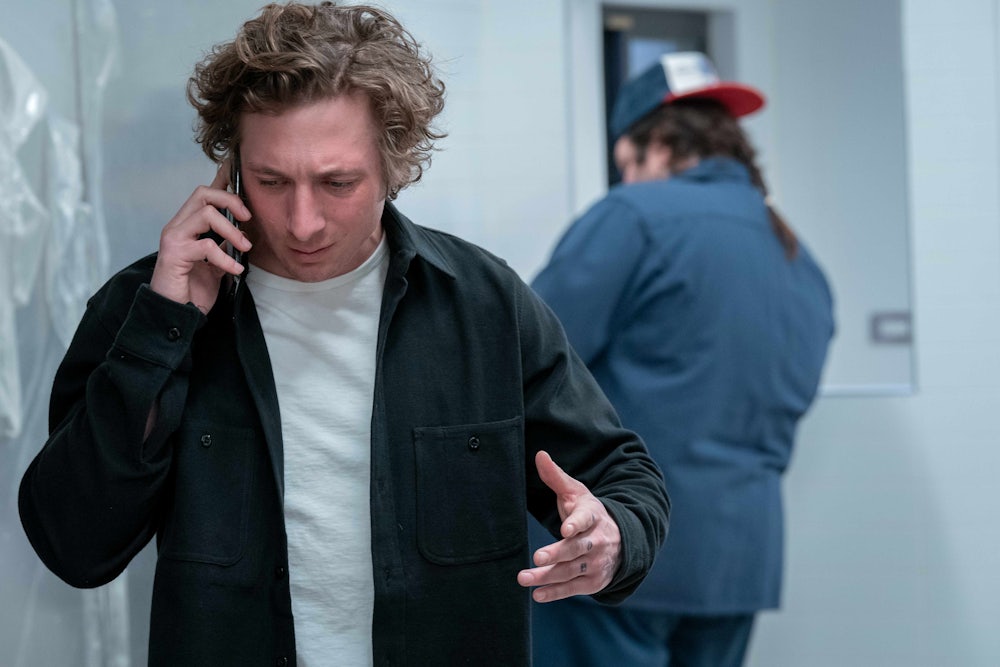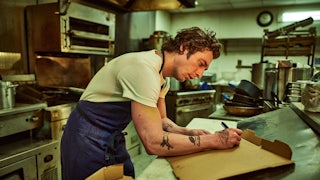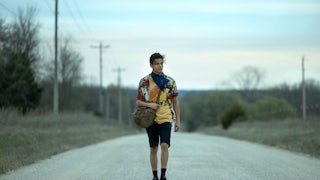Are you a “Fishes” person or a “Forks” person? To some extent, many of the best (and some of the worst) TV shows of this past year existed in the tortured gap between these two standout episodes of The Bear’s second season. Two episodes, two moods, two difficulty settings. “Fishes” was the emotional Grand Guignol of the show’s sophomore outing. It’s a Christmas flashback episode that fleshes out protagonist Carmy’s tense family dynamics and efficiently gives us context for lots of his motivating traumas. And it’s filled, like a big fat cannoli, with guest stars. Jamie Lee Curtis ravaged by grief and lit up by rage, her red claws coated in butter and salmonella; Bob Odenkirk and Jon Bernthal menacingly playing the highest-stakes game of spoons you’ve ever seen; John Mulaney looking like he won a contest to be an extra on his favorite show. It’s an exhausting hour, an excessively loud, excessively stunt-cast, hot, wet slice of serial TV.
I think this season of The Bear is one of the five best series of the year, but I’ll admit that this is the episode I liked the least, even for all the attention it garnered. It didn’t accomplish, with all its volume, half of what the show otherwise accomplished in a dozen whispered intimacies prior to this volcanic eruption. As you might guess, I’m more of a “Forks” guy.
The best compliment I can give to the hysterical overload of “Fishes” is that its grim intensity renders the joyful workplace romance of “Forks” almost incandescent if viewed in quick sequence. In this episode, we follow Cousin Richie as he stages at a fine-dining restaurant, at first resisting the pretensions of its fastidious service but eventually leaving a convert. “Fishes” knocks you down on the ground; “Forks” gets you back up, brushes the dirt off your shoulders, and sends you flying into the heavens. Cousin Richie’s redemption, the deep-dish pizza surprise, the front-of-house back-of-house flirtations, the mushroom peeling, that one tasteful Olivia Colman cameo, the Taylor Swift soundtrack—it’s maybe the most euphoric episode of television I’ve seen this year. By the time we’re in Richie’s car and Taylor hits that key change in “Love Story” and Richie hits the gas pedal singing—This love is difficult, but it’s real—all that trauma is in the past. Sure it’s a trick, and sure it’s a fantasy, but it sure feels good.
“Fishes” vs. “Forks” was adjudicated over and over on social media this summer. Do you want your TV to be emotionally devastating, to be hard to watch, to linger like a cloud over your head when you’ve finished viewing? Or do you want your TV to give you a shot in the arm, to buoy you at best or pleasantly float away at worst? It’s a question of difficulty. How much do you want to suffer? How much do you want to work? How do you want to feel? In any number of ways, 2023 was a difficult year for the television industry, on-screen and off. How hard does this have to be?
As 2023 began, TV series were disappearing. While this was by no means the primary inciting incident of the labor actions to come, throughout the latter half of 2022, news stories kept popping up reporting that various different streamers and production companies were taking their original series—even popular favorites like Westworld—off the platforms and either selling them to free, ad-supported streaming services or packing them up in mothballs. The situation was as startling for the bleak future it foretold—many of the series that were pulled from the apps were never released on physical media—as it was for the attitude it displayed from executives toward the artists who produce content for them. If the streaming revolution once promised creative freedom and support to artists, the events of late 2022 made it clear that that vision was now both outdated and naïve.
And so the writers, and then the actors, went on strike. They said that it was intolerable for production companies to try to limit the size of writers’ rooms, to dismantle the apprenticeship model that allowed writers to produce their own episodes on set, to crush a model of collaborative creative practice that had sustained television as a medium for decades upon decades, in the service of optimizing shareholder value. They demanded that studios agree to pay residuals to writers for streaming series the way they pay residuals for syndication and, beyond that, to reveal at least some of the occult viewership numbers that might clue writers in to their own worth in this economy. And they railed against the implicit notion that studios could use artificial intelligence to replace their minds and their bodies.
The
2023 WGA strike, like any labor action, was both an act of advocacy for
fairness and a tacit acknowledgment that the interests of artists and the
interests of the corporations that benefit from their work are not always
aligned. While the strike was ultimately resolved in a way that satisfied most
members of the WGA, the fight itself leaves the industry unsettled. This was
not just a dispute about pay rates and benefits. The WGA strike revealed what
the studios think about their writers. Their buy-in to A.I. hype narratives was a
tell. No writer in Hollywood is worried that an A.I. tool can replace them;
what’s worrisome is that TV executives don’t agree.
If the TV landscape of 2023 was defined by these difficult negotiations and the strained détente reached between writers and studios off-screen, difficulty was also an aesthetic on-screen. Many of this year’s most notable shows, in other words, swam with “Fishes” in a sea of raw trauma and psychic violence. And while these were magnetic screen dramas, they were also, regularly, hard to take. Netflix’s Beef trained an unblinking gaze upon two characters who find each other within a cultural ecosystem defined by anger, despair, prejudice, and economic injustice. It begins on the edge of suicide and stays there. Succession asked us, finally, to grieve Logan Roy, whose emotional abuse of each of his children in turn transformed them into ghouls. I’ve never wanted to voluntarily leave so many scenes of poisonous social interaction. Barry finally left us in an unbearable space of moral vacancy and hollow horror. The Curse constructed a virtual Hell House of discomfort and cringe. I’m a Virgo utilized its bouncy, fantastical setup to access difficult truths about the (almost literal) dehumanization of Black people within the health care system, the job market, and the housing system.
Even our most innocuous entertainments put us through it. On Bluey, this year, we saw a wrenching and extraordinary conversation between two estranged sisters—both cartoon blue heelers—about infertility and grief. The Golden Bachelor, the largely feel-good spin-off about elderly folks falling in love, ended with a long, devastating scene of heartbreak. As a contestant righteously lambasted the show’s dopey lead for leading her on, viewers felt satisfaction but also the terrible weight of mortality hanging over all this life-affirming positivity. “Time is running out,” she confided to the camera. “What have I done?” her ex cried.
This isn’t exactly new. Nearly 10 years ago, I wrote about what I called “endurance TV,” shows that essentially dared you to keep watching through brutal, unblinking set piece after brutal unblinking set piece. There’s nothing inherently good, or even inherently insightful, about training the camera on the face of a woman being stoned to death or giving us an intimate visual account of a man performing surgery on himself, but I also don’t think it’s necessarily a coincidence that the two shows I wrote about in that essay—The Leftovers and The Knick—still hold up as two of the most innovative and ingenious series of their era. There are images from those shows, not even images of violence or gore, that have hung on to me over the years. They are images that have lasted because they were hard to come by.
But why does it have to be so hard? Years ago, the film critic J. Hoberman wrote about the early twenty-first-century trend in movies about “unspeakable suffering.” From the emotionally ravaging dramas of Alejandro González Iñárritu to the rise of the “torture porn” genre to The Passion of the Christ, many films of that era reveled in the depiction of characters trapped in physical and psychic extremes. These films aggressively sought to make viewers feel their pain, to make them hurt vicariously. Hoberman argued that this trend was the result of both a medium in crisis and a culture in crisis. Film’s assertion of its power to physically touch viewers was a response to the rise of the digital, the increasing immateriality of the film medium itself. And beyond that, these films reflected and refracted the national trauma of 9/11 as well as the escalating atrocities committed by American hands abroad in response.
I don’t think it’s wrong to suggest that some of this year’s televisual difficulty emerges from a similar sense of crisis. This is a period of transformation in the medium, good and bad. The WGA won writers a more equitable journey through the coming changes, but there’s no doubt that those changes will reshape the industry and the art form in the long run. These shows make us feel that transformation viscerally. They are messily, awkwardly trying out the borders of the form, asserting the human complexity of the task of moving the medium forward. And they reflect and refract a world whose violence is inexorable, incurable, impossible to look away from; impossible, it seems, to stop.
Perhaps it is because of all this difficulty, all of this horror and immortal cringe, that this year’s best television show was also its easiest to watch. The second season of HBO’s Somebody, Somewhere was a gentle revelation. The premise of the show is that fortysomething Sam (Bridget Everett) returns home to the suffocating small town of Manhattan, Kansas, to care for her dying sister. The series begins after Sam’s sister has passed and Sam is still lingering in Manhattan, working a dead-end job, stumbling into argument after argument with her overbearing sister, her cruel mother, her sweetly detached dad, trying to process a heartache nobody seems willing to name out loud. That is, until she meets Joel (Jeff Hiller) and until she finds affirmation and a sense of belonging in a small, vibrant, self-sustaining, queer community thriving amid the cornfields.
Somebody, Somewhere is quiet, sweet, and incredibly funny. It goes down easy—it takes its time, it treats all of its characters with great affection, it balances scenes of contemplative dialogue with scenes of riotous entertainment. It’s a show about the radical potential of hospitality that goes out of its way to be hospitable to us as viewers, to treat us with the delicacy we might need, to welcome us. Creators Hannah Bos and Paul Thureen build a kind, Midwestern atmosphere with breathable air. But it is not without difficulty. This is a show about grief, loneliness, sickness, betrayal, self-sabotage, the dissolution of marriages, the dissolution of friendships, the failure of small business, the cruelty of aging, the cruelty of parents and siblings and a world that might not see you. It names these things and stays with them, but it chooses community in the end. The show’s wisest character is agriculture professor Fred Rococo (played by legendary drag king Murray Hill). Fred cares for Sam’s father’s farm. He teaches his students how to help things grow there. Sam’s father leaves his land behind, but it is not abandoned.
During the months that Somebody, Somewhere was serialized this year, I found myself appending it to these other more difficult series, as if it were a floating “Forks” available to dissolve the tension. HBO even programmed it that way, airing it immediately after episodes of the final season of Succession, right up until the end. You witnessed Kendall’s devastation, Shiv selling her soul finally, the brats getting what was coming to them, and then you could see Sam perform Laura Branigan’s “Gloria” at Fred Rococo’s wedding in her father’s barn. They all raise a toast to agriculture, to lost friends and family, and this improbable coda to another difficult Sunday night feels like a kind of ecstasy.
Somebody, Somewhere was and is hard. But it’s built around the idea that other people can save you. And, despite all the difficult TV on our screens this year, it’s not alone. Not incidentally, my top shows of this year—Somebody, Somewhere, The Bear, I’m a Virgo, Reservation Dogs, even Bluey—share this investment in representing the necessity of community. This year in TV and in the world that TV impossibly tries to mediate for us, we’ve seen cynicism and narcissism and multitudinous examples of love’s failures and the limits of humanity. We’ve seen abandonment and exploitation and unspeakable suffering. But we’ve also seen solidarity. This love is difficult, but it’s real.






